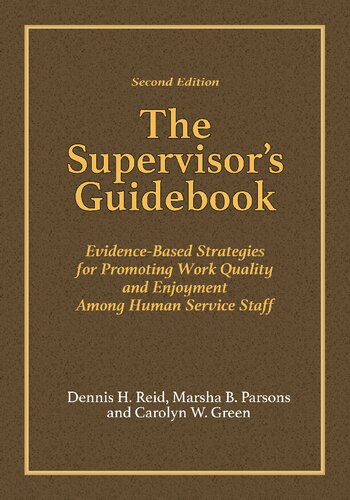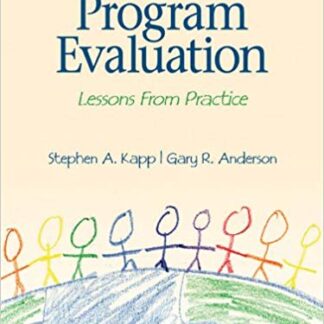Description
The Supervisor’s Guidebook: Evidence-Based Strategies for Promoting Work Quality and Enjoyment Among Human Service Staff 2nd Edition by Dennis H. Reid, ISBN-13: 978-0398093600
[PDF eBook eTextbook]
- Publisher: Charles C Thomas Pub Ltd; 2nd edition (March 10, 2021)
- Language: English
- 340 pages
- ISBN-10: 0398093601
- ISBN-13: 978-0398093600
This guidebook will show how supervisors can ensure support staff to deliver quality services for people with disabilities whose quality of life is heavily dependent on how well those services are provided. Supervisors must ensure staff receive necessary training in their job duties, are actively supported to stay motivated to work proficiently and, at times, effectively assisted to improve their work performance. Supervisors have to overcome many challenges to fulfill these critical duties, often involving frequent changes in their staff work force and varying or limited resources. Complicating the job of staff supervisors is a lack of formal training necessary to perform their supervisory duties effectively. When supervisors do receive training in how to supervise staff work performance, the training is not always very useful. The training is frequently too general to equip supervisors with knowledge and skills to affect staff work performance on a routine basis. The training also is commonly based on unproven means of promoting quality staff performance, stemming from current fads or ideology that has little if any hard evidence to support the training content. Over the last five decades, a technology for supervising staff work performance in the human services has been evolving, derived from applied research conducted in many human service agencies. However, most supervisors have not had opportunities to become aware of these evidencebased means of fulfilling their supervisory duties. The purpose of The Supervisors Guidebook is to describe the existing evidencebased approach to supervision. Description of the approach is supplemented with practical suggestions based on the authors combined experience encompassing over 100 years of supervising staff performance in the human services. The intent is to provide supervisors with detailed information about tried and tested means of promoting diligent and proficient staff performance and to do so in a way that maximizes staff enjoyment with their work.
Table of Contents:
THE SUPERVISOR’S GUIDEBOOK
ABOUT THE AUTHORS
PREFACE
ACKNOWLEDGMENTS
CONTENTS
Section I INTRODUCTION TO SUPERVISION
Chapter 1 THE IMPORTANCE OF SUPERVISION
WHAT IS SUPERVISION?
SUCCESSFUL SUPERVISION INVOLVES PROMOTING STAFF WORK ENJOYMENT
EVIDENCE-BASED SUPERVISION
PURPOSE OF THE SUPERVISOR’S GUIDEBOOK
INTENDED AUDIENCE OF THE SUPERVISOR’S GUIDEBOOK
ORGANIZATION OF THE SUPERVISOR’S GUIDEBOOK
CHAPTER SUMMARY: KEY POINTS
Chapter 2 AN EVIDENCE-BASED PROTOCOL FOR SUPERVISING STAFF PERFORMANCE
STEPS CONSTITUTING AN EVIDENCE-BASED APPROACH TO SUPERVISION
Step 1: Identify Client Outcomes
Step 2: Specify Staff Performance
Step 3: Train Work Skills to Staff
Step 4: Monitor Staff Performance
Step 5: Support Proficient Staff Performance
Step 6: Correct Nonproficient Staff Performance
Step 7: Evaluate Staff Performance
IMPLEMENTING STEPS OF THE SUPERVISORY PROTOCOL IN WAYS TO ENHANCE WORK ENJOYMENT
A PRACTICAL CONCERN WITH EVIDENCE-BASED SUPERVISION
CHAPTER SUMMARY: KEY POINTS
Section II CRITICAL SUPERVISORY SKILLS
Chapter 3 SPECIFYING STAFF WORK RESPONSIBILITIES
THREE CRITERIA FOR SPECIFYING STAFF PERFORMANCE RESPONSIBILITIES
Criterion 1: Performance Responsibilities Must be Described in Terms of Staff Work Behavior
Criterion 2: Performance Responsibilities Must be Described in Terms of Work Behavior That Can be Di
Criterion 3: Performance Responsibilities Must be Specified as Observable Work Behavior Such That Pe
STRATEGIES FOR SPECIFYING PERFORMANCE RESPONSIBILITIES
Performance Checklists
Work Activity Schedules
SPECIFYING PERFORMANCE RESPONSIBILITIES IN WAYS ACCEPTABLE TO STAFF
CHAPTER SUMMARY: KEY POINTS
Chapter 4 TRAINING WORK SKILLS TO STAFF
BASIC GOALS OF STAFF TRAINING
BEHAVIORAL SKILLS TRAINING
Training Step 1: Describe Target Skills to be Trained
Training Step 2: Provide A Written Summary of the Target Skills
Training Step 3: Demonstrate How to Perform the Target Skills
Training Step 4: Trainee Practice with Supervisor Feedback
Training Step 5: Repeat Step 4 Until Staff Perform The Target Skills Proficiently
TWO MAIN FORMATS FOR TRAINING STAFF
Training Staff in a Group
Training Staff Individually
GENERAL CONSIDERATIONS WHEN CONDUCTING BEHAVIORAL SKILLS TRAINING WITH STAFF
Reducing Time and Effort to Conduct Behavioral Skills Training
Ensure Staff Competence During Role-Play Activities.
Use of Media-Based Training.
Pyramidal Training.
Making Training Acceptable to Staff
A QUALIFICATION WITH STAFF TRAINING
CHAPTER SUMMARY: KEY POINTS
Chapter 5 MONITORING STAFF PERFORMANCE
FORMAL MONITORING
INFORMAL MONITORING
SPECIAL CONSIDERATIONS WITH MONITORING
Staff Reactivity to Monitoring
Overt Versus Covert Monitoring
PROMOTING STAFF ACCEPTANCE OF PERFORMANCE MONITORING BY A SUPERVISOR
Follow Specific Guidelines When Formally Monitoring Staff Performance
Use a Participative Approach When Developing a Formal Monitoring System
Ensure Personnel Who Observe for Supervisors Monitor in a Way Acceptable to Staff
CHAPTER SUMMARY: KEY POINTS
Chapter 6 SUPPORTING PROFICIENT WORK PERFORMANCE: POSITIVE FEEDBACK
THE POWER OF POSITIVE FEEDBACK
AN EVIDENCE-BASED PROTOCOL FOR PROVIDING FEEDBACK
Step 1: Begin Feedback with A Positive or Empathetic Statement
Step 2: Specify What Staff Performed Correctly
Step 3: Specify What Staff Performed Incorrectly, If Applicable
Step 4: Specify What Needs to be Done to Correct the Behavior Identified in Step 3
Step 5: Solicit Questions About the Information Provided
Step 6: Inform Staff About Subsequent Supervisory Actions
Step 7: End Feedback Session with a Positive or Empathetic Statement
SPECIAL CONSIDERATIONS WHEN USING THE EVIDENCE-BASED FEEDBACK PROTOCOL
Feedback as a Unique Skill
Providing Feedback in Difficult Situations with Staff
Feedback Must Be Sincere
Maintaining Privacy with Feedback
A Reported Concern with the Feedback Protocol
DIFFERENT WAYS OF PROVIDING FEEDBACK
Informal Feedback
Written Feedback
Advantages of Written Feedback.
Disadvantages of Written Feedback.
Special Considerations with Providing Written Feedback.
Individual Versus Group Feedback
Publicly Posted Feedback
Immediate Versus Delayed Feedback
Outcome-Based Feedback
Provide Feedback in Multiple Ways
CHAPTER SUMMARY: KEY POINTS
Chapter 7 SUPPORTING PROFICIENT WORK PERFORMANCE: SPECIAL RECOGNITION PROCEDURES
SPECIAL RECOGNITION AWARDS
Peer Awards
Formal Staff Appreciation Events
Performance Lotteries
SPECIAL RECOGNITION ACTIONS
Special Recognition Meetings
Taking Home the Goods
Receiving the Goods at Home
Saying Good Things Behind the Back
Stand-up Supervision
Relief of Duty
USING MONEY FOR SPECIAL RECOGNITION
CHAPTER SUMMARY: KEY POINTS
Chapter 8 CORRECTING NONPROFICIENT WORK PERFORMANCE
PREREQUISITES FOR CORRECTIVE SUPERVISION
A SERIOUS MISCONCEPTION ABOUT HOW TO CORRECT NONPROFICIENT PERFORMANCE
COMMON REASONS FOR NONPROFICIENT STAFF PERFORMANCE AND SUPERVISOR CORRECTIVE ACTIONS
Lack of Skills to Perform Job Duties
Lack of Resources to Perform Job Duties
Incapability of Performing Duties
Lack of Motivation
Providing Feedback to Overcome Insufficient Work Motivation.
Disciplinary Action for Improving Nonproficient Staff Performance Due to Lack of Motivation.
PERFORMANCE PROBLEMS DUE TO REASONS OUTSIDE OF THE WORK PLACE
CHAPTER SUMMARY: KEY POINTS
Chapter 9 PROMOTING STAFF WORK ENJOYMENT: MAKING DISLIKED WORK TASKS MORE ENJOYABLE TO PERFORM
GENERAL CONSIDERATIONS FOR MAKING WORK TASKS MORE ENJOYABLE FOR STAFF TO PERFORM
AN EVIDENCE-BASED APPROACH FOR MAKING DISLIKED WORK TASKS MORE ENJOYABLE TO PERFORM: TEMP
TEMP Step 1: Identify Reasons Staff Dislike Performing a Work Task
TEMP Step 2: Identify Potential Ways to Alter the Work Task
TEMP Step 3: Make as Many Identified Task Changes as Possible
TEMP Step 4: Meet Again with Staff to Review Actions and Determine Additional Actions
AN EXAMPLE OF HOW TEMP HAS BEEN USED TO MAKE A DISLIKED WORK TASK MORE ENJOYABLE TO PERFORM
SPECIAL CONSIDERATIONS FOR ADDRESSING HIGHLY DISLIKED WORK TASKS
Work-Task Dislike Due to Characteristics of Individual Clients
Focus on Most Disliked Work Tasks
Disliked Work Tasks That Cannot be Changed
CHAPTER SUMMARY: KEY POINTS
Section III RESOLVING COMMON PERFORMANCE PROBLEMS
Chapter 10 RESOLVING COMMON PERFORMANCE PROBLEMS: OVERVIEW
THE BASIC PREMISE OF SUPERVISOR ACCOUNTABILITY
SUPERVISING IN DIFFICULT SITUATIONS
Maintain Frequent Communication with Staff
Stay Focused on Actively Supervising Staff Performance
Supervisor Self-Motivation
Establish a Work Goal.
Achieve the Goal.
Reinforce the Accomplishment.
CHAPTER SUMMARY: KEY POINTS
Chapter 11 REDUCING ABSENTEEISM
REASONS FOR FREQUENT ABSENTEEISM
SPECIFYING ACCEPTABLE AND UNACCEPTABLE ABSENTEEISM
High-Frequency Absenteeism
Predictable Absenteeism
Extended Duration Absenteeism
ABSENTEE-REDUCTION STRATEGIES
Supporting Acceptable Work Attendance and Correcting Unacceptable Absenteeism
Preventing Absentee Problems: Promoting Work Enjoyment as Part of Supervision.
Group-Contingency Strategies.
Absentee-Reduction Strategies with Individual Staff.
TWO FINAL CONSIDERATIONS FOR REDUCING ABSENTEEISM
The Importance of Flexibility with Absentee-Reduction Strategies
Attending to Planned and Unplanned Absences
CHAPTER SUMMARY: KEY POINTS
Chapter 12 RESOLVING PROBLEMS WITH STAFF PROVISION OF CLIENT-TEACHING SERVICES
IMPROVING FORMAL TEACHING SERVICES
Improving Staff Proficiency in ConductingFormal Teaching Procedures
Training Staff to Teach.
Maintaining Staff Proficiency in Providing Formal Teaching Services Following Training.
Ensuring Staff Conduct Formal Teaching as Often as Expected
Motivating Staff to Conduct Teaching Sessions.
PROMOTING NATURALISTIC TEACHING DURING ROUTINE ACTIVITIES
Training Staff How to Teach During Routine Client Activities
Ensuring Staff Perform Naturalistic Teaching After Receiving Training
SPECIAL CONSIDERATIONS FOR OVERCOMING PERFORMANCE PROBLEMS WITH TEACHING SERVICES
Resolving Problems with Data Collection and Documentation
Problematic Issues with Treatment Services for Challenging Behavior
CHAPTER SUMMARY: KEY POINTS
Chapter 13 REDUCING FREQUENT NONWORK BEHAVIOR
SPECIAL CONSIDERATIONS IN APPLYING CERTAIN STEPS OF EVIDENCE-BASED SUPERVISION TO REDUCE NONWORK BEH
Specifying Performance Expectations with Activity Schedules
The Critical Role of Supervisor Monitoring in Preventing and Decreasing Nonwork Behavior
Focusing Positive Feedback on Desired Work Behavior
GENERAL CONSIDERATIONS FOR REDUCING FREQUENT NONWORK BEHAVIOR
Reasonable Goals for Nonwork Behavior
Supervisor Flexibility in Addressing Nonwork Behavior in Certain Situations
Nonwork Behavior Following Challenging Situations.
Consideration of Staff Break Times.
Consideration of Exceptions to Typically Diligent Work.
Reducing Subtle Types of Frequent Nonwork Behavior
CHAPTER SUMMARY: KEY POINTS
Section IV SUPERVISING FROM A DISTANCE (TELEHEALTH)
Chapter 14 SUPERVISING FROM A DISTANCE WITH TELEHEALTH
SUPERVISION VIA TELEHEALTH: AN OVERVIEW
Ways of Providing Supervision via Telehealth
Required Resources for Providing Supervision via Telehealth
Skills for Supervising with Telehealth
Ethical Requirements for Using Telehealth
TELEHEALTH SPECIFICALLY FOR IMPLEMENTING EVIDENCE-BASED SUPERVISORY PROCEDURES FROM A DISTANCE
Training Staff Through Telehealth
Monitoring Staff Performance Through Telehealth
Logistical and Technical Issues with Distance Monitoring.
Effectiveness Issues with Distance Monitoring.
Staff Acceptability Issues with Distance Monitoring.
Supporting Staff Performance Through Telehealth
Correcting Staff Performance Through Telehealth
CHAPTER SUMMARY: KEY POINTS
Section V SELECTED READINGS
SELECTED READINGS
TRAINING STAFF TO TEACH PEOPLE WITH INTELLECTUAL AND DEVELOPMENTAL DISABILITIES
TRAINING OTHER WORK SKILLS TO STAFF
IMPROVING AND MAINTAINING ONGOING AREAS OF STAFF PERFORMANCE (VARYING JOB DUTIES)
PROMOTING SUPPORTIVE SOCIAL INTERACTIONS WITH CLIENTS
PROMOTING TREATMENT SERVICES SPECIFIC TO GROUPS OF CLIENTS
PROMOTING QUALITY PERSONAL CARE AND SUPPORT FOR CLIENTS
PROMOTING QUALITY DATA COLLECTION AND RECORDKEEPING BY STAFF
PREVENTING AND REDUCING ABSENTEEISM
PROMOTING WORK ENJOYMENT
DISTANCE SUPERVISION THROUGH TELEHEALTH
REVIEW AND DISCUSSION PAPERS RELATED TO EVIDENCE-BASED SUPERVISION
BOOKS RELATED TO EVIDENCE-BASED SUPERVISION
TRAINING CURRICULA FOR SUPERVISORS
INDEX
What makes us different?
• Instant Download
• Always Competitive Pricing
• 100% Privacy
• FREE Sample Available
• 24-7 LIVE Customer Support






